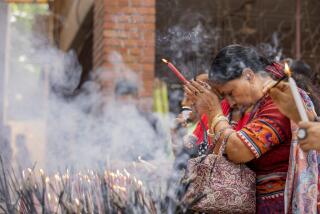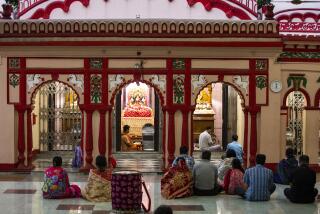National Agenda : Riots Reveal Flaws in India Establishment : Every major institution failed. Now the country strives to regain secularism.
- Share via
NEW DELHI — As fires and riots raged on all sides in the capital’s crowded Seelampur District last week, fire department Deputy Inspector Santokh Singh leaned wearily against a brick wall, took off his battered yellow helmet and rubbed his beard.
“It is awful, terrible,” he said, shaking his head. “So much hatred. So much bloodshed. What will become of us?”
Similar questions are being asked across India today as the world’s largest democracy struggles to regain its balance from a week of savage bloodletting and seeming madness over the Dec. 6 assault by militant Hindus on the Muslim mosque at Ayodhya. The answers are not encouraging.
Not since the slaughter of partition and independence 45 years ago has the vast country seemed so consumed by communal conflagration. The level of carnage--more than 1,250 were killed, according to government-controlled media, but official sources say the toll is much higher--was less important than the fact that religious riots spread so far, so fast and so furiously.
Even worse, virtually every major institution failed: An indecisive prime minister and the weak central government appeared helpless to prevent or deal with the mounting crisis. The second-largest political party and the largest state government openly defied a Supreme Court order to protect the mosque. Indian and foreign journalists were systematically assaulted while hundreds of state police looked on and did nothing.
The national Parliament could not control its own members for six shrieking sessions and was finally adjourned in despair for a week. In city after city, paramilitary and police troops fired aging single-bore rifles and submachine guns into unarmed crowds. In some cases, Hindu police joined or at least stood by during anti-Muslim rioting. Unofficial sources say 80% of the victims were Muslims.
To the outside world, the issue was arcane at best. Militant fundamentalist Hindus attacked and demolished a shabby, crumbling 16th-Century mosque that they said was built over the birthplace of Lord Rama, a warrior-king seen as an incarnation of the Hindu god Vishnu. The mosque had not even been used since 1948, when the dispute first arose.
But Ayodhya stood as a symbol for a host of ancient religious grievances in a country where the overwhelming Hindu majority somehow feels oppressed by a Muslim minority. Political demagogues and Hindu fanatics in the Bharatiya Janata Party rose to power by exploiting religious tension and calling for the creation of a fundamentalist Hindu state and the start of the Ram Rajya, the Empire of Ram.
To Hindus and Muslims alike, therefore, Ayodhya goes to the heart of whether the country maintains the secular identity guaranteed in its constitution. And it raises the question of the rights of the Muslim minority in an increasingly fractious, multi-religious society.
“India is experiencing the kind of polarization that never took place before,” said Prof. Saifuddin Soz, a moderate member of Parliament who is active in the National Council for Integration, a government-led group that seeks to heal the nation’s divisions. “This was an attack on the very edifice of secularism in India. The damage is very deep.”
“The lesson of this week for 100 million Muslims is we have no protection,” said Saeed Khan, a print-shop owner and former Delhi municipal counselor. “Our mosque couldn’t be protected. And once the riots began, we were the targets, not only of the Hindus but of the police.”
“India’s secularism is only on paper now,” said Syed Abdullah Bukhari, the burly, bearded imam of the Jama Masjid in Old Delhi, the country’s largest and most important mosque. “This is the death of secularism.”
Such dire sentiments are widely shared here by academics, clerics, columnists and politicians. But a few aren’t so sure.
India is a vast and resilient nation that has survived severe shocks before and surely will again, they say. The country is so immense--with a population of 138 million, Uttar Pradesh state alone, where Ayodhya is located, has more people than Japan, England, France or Germany--that problems tend to get swallowed in a complex national weave that often seems a universe unto itself, cut off and unique from the rest of the world.
Since independence, India has repeatedly endured carnage, rage and revolt. There were three full-scale wars with Pakistan, bloody riots and secessionist rebellions, and the shocking series of political assassinations--from Mahatma Gandhi to Prime Minister Indira Gandhi to her son, former Prime Minister Rajiv Gandhi. The country survived.
“You know we are in the middle of a hurricane now,” said M.J. Akbar, a former member of Parliament and prominent newspaper editor in Calcutta. “It’s very difficult to see how much damage a hurricane is doing while it’s under way. And it’s very difficult to remember that the sun will come out again.”
Certainly India’s prime minister, the ever-cautious P.V. Narasimha Rao, hopes the storm of violence will pass with little effect. At a news conference at his residence Friday, the frail, 72-year-old leader of the Congress Party insisted the worst was over and “the normal life of harmony in India will continue.
“India has gone through these upheavals before and come out many times stronger,” he said. “I do not think this will be a permanent setback.”
Rao insisted he bore no blame for the crisis, saying he relied on the Uttar Pradesh state government, then controlled by the Hindu Fundamentalist Party, to provide security at the much-disputed mosque even after 200,000 Hindus had gathered vowing to destroy it. “I do not think the responsibility lies on me,” Rao said.
Where the blame belongs is now less important, perhaps, than where the future lies. Doubts are growing about Rao’s ambitious economic reform program, the most significant restructuring of India’s socialist economy since independence. Over the last 16 months, his Cabinet has moved steadily, if slowly, to reduce the deficit, cut spending, liberalize foreign investment laws and lower tariffs, among other key reforms.
“Yes, there will be some temporary setbacks,” Rao conceded, but he added that the “merits of the economic reform program are so obvious it will not fail.” Others are less sure, because Rao is now seeking alliances with the country’s Communists to hold his minority government together.
The political situation is also less than encouraging. For one thing, Rao publicly promised to rebuild the Ayodhya mosque. If he does so, it would mean dismantling the makeshift Hindu temple already erected on the site, a near-certain recipe for more riots. If he doesn’t, he forfeits critical Muslim support necessary for his programs.
“Each time, the hurricane gets worse,” Akbar said. “I suppose societies don’t crumble so easily. But I know the hurricane’s fury is intensifying. And this is the worst yet.”
More to Read
Sign up for Essential California
The most important California stories and recommendations in your inbox every morning.
You may occasionally receive promotional content from the Los Angeles Times.











